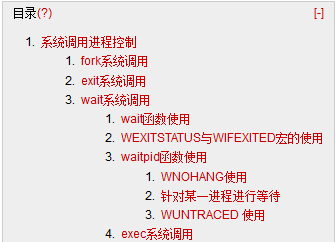Linux学习记录--进程控制相关系统调用
系统调用:进程控制
fork系统调用
函数作用:创建一个子进程
形式:pid_tfork(void);
pid_t vfork(void);
说明:使用vfork创子进程时,不会进程父进程的上下文
返回值:[返回值=-1]子进程创建失败
[返回值=0]子进程创建成功
[返回值>0]对父进程返回子进程PID
#include <stdio.h>
#include <sys/stat.h>
#include <unistd.h>
int main() {
pid_t id = fork();
if (id < 0) {
perror("子进程创建失败!");
} else {
if (id == 0) {
printf("子进程工作:PID=%d,PPID=%d\n", getpid(), getppid());
}else
{
printf("父进程工作:PID=%d,PPID=%d,子进程PID=%d\n", getpid(), getppid(),id);
sleep(5)
}
}
}
控制台输出
父进程工作:PID=3173,PPID=2432,子进程PID=3176
子进程工作:PID=3176,PPID=3173
exit系统调用
函数作用:终止发出调用的进程
形式:voidexit(int status);
说明
1. exit返回信息可由wait系统函数获得
2. 如果父进程先退出子进程的关系被转到init进程下
#include <stdio.h>
#include <sys/stat.h>
#include <unistd.h>
#include <stdlib.h>
int main() {
pid_t id = fork();
if (id < 0) {
perror("子进程创建失败!");
} else {
if (id == 0) {
printf("子进程工作:PID=%d,PPID=%d\n", getpid(), getppid());
sleep(20);
printf("此时子进程:PID=%d,PPID=%d\n", getpid(), getppid());
}else
{
printf("父进程工作:PID=%d,PPID=%d,子进程PID=%d\n", getpid(), getppid(),id);
sleep(5);
exit(3);
}
}
return 0;
}
控制台输出
父进程工作:PID=3068,PPID=2432,子进程PID=3071
子进程工作:PID=3071,PPID=3068
此时子进程:PID=3071,PPID=1
wait系统调用
函数作用:父进程与子进程同步,父进程调用后。进入睡眠状态,直到子进程结束或者父进程在被其他进程终止,
形式:pid_twait(int *status)
pid_t waitpid(pid_t pid ,int *status,int option)
参数:statusè exit是设置的代码
pid è进程号
option: WNOHANG|WUNTRACED
WNOHANG:,即使没有子进程退出,它也会立即返回,不会像wait那样永远等下去.
WUNTRACED:子进程进入暂停则马上返回,但结束状态不予以理会.
返回值:如果成功等待子进程结束,则返回子进程PID。后者为-1
用来检查子进程返回状态的宏
WIFEXITED这个宏用来指出子进程是否为正常退出的,如果是,它会返回一个非零值.
WEXITSTATUS当WIFEXITED返回非零值时,我们可以用这个宏来提取子进程的返回值
wait函数使用
#include <sys/types.h>
#include <sys/uio.h>
#include <string.h>
#include <fcntl.h>
#include <unistd.h>
#include <sys/wait.h>
#include <stdio.h>
#include <stdlib.h>
int main() {
pid_t cid;
cid = fork();
if (cid < 0) {
perror("子进程创建失败!");
} else {
if (cid == 0) {
printf("子进程工作\n");
printf("子进程PID=%d,PPID=%d\n", getpid(),getppid());
//sleep(20); //1
} else {
//wait(NULL);//2
//sleep(20);//3
printf("父进程工作\n");
printf("父进程PID=%d,PPID=%d\n", getpid(),getppid());
}
}
return 0;
}
针对上述代码作以下分析:
1. 当子进程退出时,如果父进程没有wait进行回收资源,子进程就会一直变为僵尸进程(Z)直到父进程退出
作法:
打开3处注释后执行程序,查看进程状态,如下
[root@localhostDebug]# ps -C Process -o pid,ppid,stat,cmd
PID PPID STAT CMD
12233 11563S /root/workspace/Process/Debug/Process
12238 12233Z [Process] <defunct>
=>可以看到子进程此时的状态时Z(僵尸进程)
控制台输出如下
子进程工作
子进程PID=12238,PPID=12233
(20S后…..)
父进程工作
父进程PID=12233,PPID=11563
2. 使用wait进行进程同步,父进程直到子进程退出,wait才会结束等待
作法:
打开1,2处注释后执行程序,查看进程状态,如下
[root@ Debug8$] ps -C Process -o pid,ppid,stat,cmd
PID PPID STAT CMD
3425 2432 S /root/workspace/Process/Debug/Process
3430 3425 S /root/workspace/Process/Debug/Process
=>父进程与子进程都处于sleep状态
控制台输出如下
子进程工作
子进程PID=3430,PPID=3425
(20S后…..)
父进程工作
父进程PID=3425,PPID=2432
3. 使用wait进行进程同步,子进程退出后,父进程结束wait等待,同时清空子进程信息,此时子进程不再是僵尸进程
作法:
打开2,3处注释后执行程序,查看进程状态,如下
[root@localhostDebug]# ps -C Process -o pid,ppid,stat,cmd
PID PPID STAT CMD
1250611563 S /root/workspace/Process/Debug/Process
=>可以看到此时只有父进程信息
控制台输出如下
子进程工作
子进程PID=12511,PPID=12506
(20S后…..)
父进程工作
父进程PID=12506,PPID=11563
WEXITSTATUS与WIFEXITED宏的使用
#include <sys/types.h>
#include <sys/uio.h>
#include <fcntl.h>
#include <unistd.h>
#include <sys/wait.h>
#include <stdio.h>
#include <stdlib.h>
int main() {
pid_t cid;
int pr, status;
cid = fork();
if (cid < 0) {
perror("子进程创建失败!");
} else {
if (cid == 0) {
printf("子进程工作PID=%d,父进程PID=%d\n", getpid(),getppid());
sleep(20);
exit(3);
} else {
pr = wait(&status);
if (WIFEXITED(status)) {
printf("父进程工作PID=%d\n", getpid());
printf("WAIT返回值=%d\n", pr);
printf("子进程正常退出PID=%d\n", getpid());
printf("WIFEXITED(status)=%d\n", WIFEXITED(status));
printf("WEXITSTATUS(status)=%d\n", WEXITSTATUS(status));
} else {
printf("子进程异常退出PID=%d,信号=%d\n", getpid(), status);
printf("WAIT返回值=%d\n", pr);
}
}
}
return 0;
}
基于上面代码做出分析:
1. 子进程正常退出
控制台输出信息如下:
子进程工作PID=12070,父进程PID=12069
(20S后…..)
父进程工作PID=12069
WAIT返回值=12070
子进程正常退出PID=12069
WIFEXITED(status)=1
WEXITSTATUS(status)=3
2. 子进程异常退出
作法:
运行程序,在子进程SLEEP期间,杀死子进程
[root@localhost Debug]# kill -9 11990
控制台台输出如下
子进程工作PID=11990,父进程PID=11985
(kill -9 PID 杀死子进程)
子进程异常退出PID=11985,信号=9
可以看出子进程正常退出时,status返回值是exit的退出值,子进程异常退出时status返回值信号值
waitpid函数使用
waitpid的参数说明
参数pid的值有以下几种类型:
pid>0时,只等待进程ID等于pid的子进程,不管其它已经有多少子进程运行结束退出了,只要指定的子进程还没有结束,waitpid就会一直等下去.
pid=-1时,等待任何一个子进程退出,没有任何限制,此时waitpid和wait的作用一模一样.
pid=0时,等待同一个进程组中的任何子进程,如果子进程已经加入了别的进程组,waitpid不会对它做任何理睬.
pid<-1时,等待一个指定进程组中的任何子进程,这个进程组的ID等于pid的绝对值.
参数options的值有以下几种类型:
如果使用了WNOHANG参数,即使没有子进程退出,它也会立即返回,不会像wait那样永远等下去.
如果使用了WUNTRACED参数,则子进程进入暂停则马上返回,但结束状态不予以理会.
如果我们不想使用它们,也可以把options设为0,如:ret=waitpid(-1,NULL,0);
WNOHANG使用
#include <sys/types.h>
#include <sys/uio.h>
#include <fcntl.h>
#include <unistd.h>
#include <sys/wait.h>
#include <stdio.h>
#include <stdlib.h>
int main() {
pid_t cid;
int pr, status;
cid = fork();
if (cid < 0) {
perror("子进程创建失败!");
} else {
if (cid == 0) {
printf("子进程工作PID=%d\n", getpid());
sleep(5);
exit(3);
} else {
do{
pr = waitpid(0,&status, WNOHANG);
if(pr==0)
{
printf("没有子进程退出,继续执行..\n");
sleep(1);
}
}while(pr==0);
printf("子进程正常退出PID=%d\n", pr);
}
}
return 0;
}
控制台输出:
没有子进程退出,继续执行..
子进程工作PID=3632
没有子进程退出,继续执行..
没有子进程退出,继续执行..
没有子进程退出,继续执行..
没有子进程退出,继续执行..
子进程正常退出PID=3632
针对某一进程进行等待
#include <sys/types.h>
#include <unistd.h>
#include <sys/wait.h>
#include <stdio.h>
#include <stdlib.h>
int main() {
pid_t cid;
int pr, status;
cid = fork();
if (cid < 0) {
perror("子进程创建失败!");
} else {
if (cid == 0) {
printf("子进程工作PID=%d,PPID=%d\n", getpid(), getppid());
sleep(20);
exit(3);
} else {
pr = waitpid(cid, &status, 0);
printf("父进程正常退出PID=%d\n", pr);
}
}
return 0;
}
控制台输出
子进程工作PID=4257,PPID=4252
父进程正常退出PID=4257
WUNTRACED 使用
#include <sys/types.h>
#include <unistd.h>
#include <sys/wait.h>
#include <stdio.h>
#include <stdlib.h>
int main() {
pid_t cid;
int pr, status;
cid = fork();
if (cid < 0) {
perror("子进程创建失败!");
} else {
if (cid == 0) {
printf("子进程工作PID=%d,PPID=%d\n", getpid(), getppid());
sleep(30);
exit(3);
} else {
pr = waitpid(cid, &status, WUNTRACED);
printf("父进程正常退出PID=%d,status=%d\n", pr,status);
}
}
return 0;
}
作法:在子进程SLEEP时,通过SHELL命令停止子进程
[root@ ~ 6$] kill -STOP PID
控制台输出
子进程工作PID=4110,PPID=4108
(SLEEP期间,停止子进程)
父进程正常退出PID=4110,status=4991
在查看进程状态,发现此时父进程子进程都已经退出
[root@ Debug 13$] ps -C Process -opid,ppid,stat,cmd
PID PPID STAT CMD
exec系统调用
函数作用:以新进程代替原有进程,但PID保持不变
形式:
int execl(const char *path, const char*arg, ...);
int execlp(const char *file, const char*arg, ...);
int execle(const char *path, const char*arg, ..., char * const envp[]);
int execv(const char *path, char *constargv[]);
int execvp(const char *file, char *constargv[]);
int execve(const char *path, char *constargv[], char *const envp[]);
举例:
exec1.c
#include <stdio.h>
#include <unistd.h>
int main()
{
printf("这是第一个进程PID=%d\n",getpid());
execv("e2",NULL);
printf("asa");
return 0;
}
exec2.c
#include <stdio.h>
#include <unistd.h>
int main()
{
printf("这是第二个进程PID=%d\n",getpid());
}
运行结果:
[root@ Process 9$] gcc -o e1 exec1.c
[root@ Process 10$] gcc -o e2 exec2.c
[root@ Process 11$] ./e1
这是第一个进程PID=3051
这是第二个进程PID=3051
